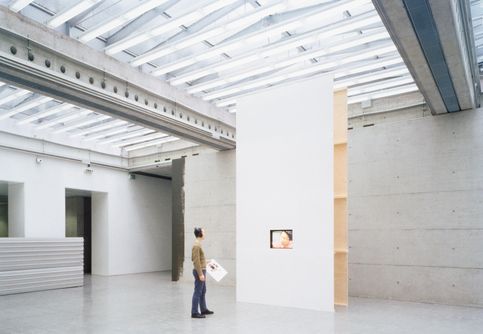Into Art

Dorit Margreiter
Into Art, 1998
Video installation Wooden construction, painted white, with integrated video monitor, 500 x 250 x 60 cm video, color, sound, 3 min 20 sec + 1 min (loop) 8 storyboards, laser prints, 29.7 x 42.2 cm each
GF0002016.00.0-1999
Artwork text
Plot The proposed TV-plot is set within an art institution founded by a private corporation. Here, various characters meet and together experience different episodes within the framework of the biographies ascribed to them. The plot is determined by the personal and social background of each actor, the functions of the institution, and the effects. The series begins with a director being appointed to the institution, which, at the time, had been in existence for three years. At this time there was a restructuring not only of staff but also of programmatic orientation. The newly constructed museum building is meant to reinforce the role of art as an image bearer for the corporation, at the same time the new insti-tution is supposed to develop its own profile within the context of international art discourse. Characters <Peter> defines himself as someone who works in “art-related contexts.” Growing up in a working class family he gained early experience in political work at the grass roots level. At the institution he works to make a living in the development team. Here he is not recognized as an artist. In a different scene, however, he is a well-known, important figure. At the beginning of the series, he organizes an exhibition and a panel on “minority politics.” He has repeatedly tried to change the institutional exhibition program from “below,” but has only had limited success. Possible topics “Class,” political activism, institutional recognition, alternative spaces, economic situation, etc. <Susanna> in the three years of its existence, she has been the director of the institution which has recently moved to a new building. She was the only female candidate and got the job following a complicated selection procedure. Her predecessor, who had begun setting up the collection and the exhibition hall, had been asked to join the head of the Getty Museum. <Susanna> sees herself under pressure to prove that she is qualified for the job not just on the basis of affirmative action but because she has the best professional qualifications. She grew up in the country in a Christian-conservative setting with her parents and a much younger sister. She was attracted to the city to study art history against her father’s will and completed her studies with honors. The theme of her Ph.D. thesis was “Art and Social Change-Art of the Sixties.” She was awarded postgraduate scholarships to Berkeley and Barnard and accepted various internships in famous museums, where she also meets her boyfriend <Michael>. Possible topics: collection policy, affirmative action, gender difference, avant-garde vs. public success, institutional representation, etc. <Dr. K> The concealed main role is not given to one particular “character.” Within the series he assumes the role of the “client.” As in other TV serials, he only appears from the “off” or in a few series on specific occasions.


